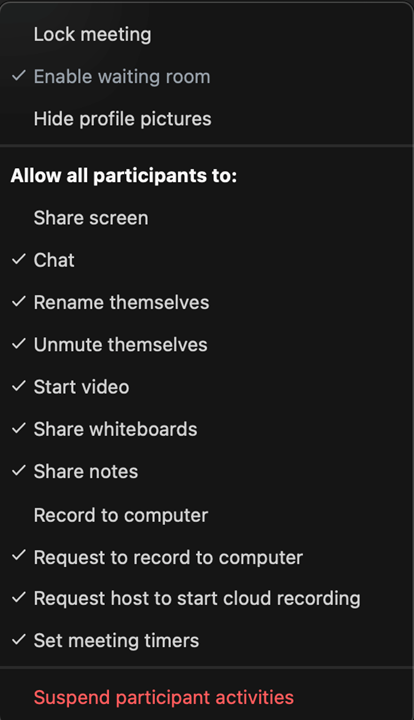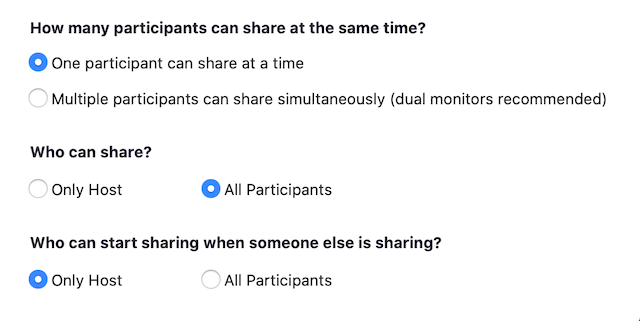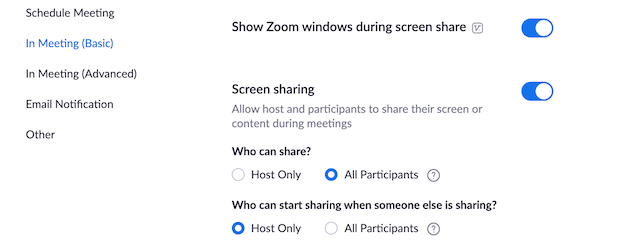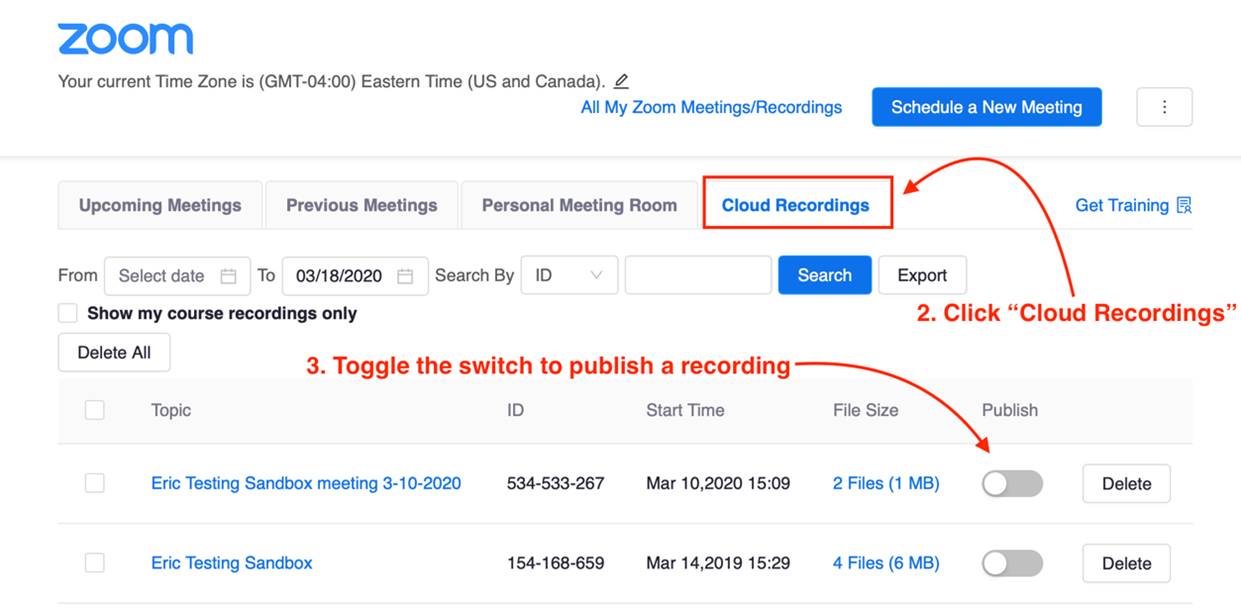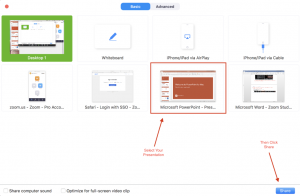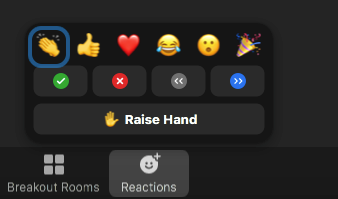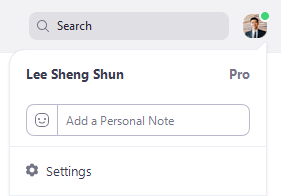Zoom at Kenan-Flagler
Zoom is a video communications software that is used for video and audio conferencing, collaboration, chat, and webinars across mobile devices, desktops, telephones, and room systems. Zoom is available for all UNC Kenan-Flagler faculty, staff, and students; it offers the ability to host online meetings of up to 300 participants. This is the primary video conferencing tool for all Undergraduate, MBA, MAC, MSM, and PhD business school students.
Direct any questions you have about your business school Zoom accounts to the following contacts.

 Example of the Individual Class Sessions
Example of the Individual Class Sessions




Direct any questions you have about your business school Zoom accounts to the following contacts.
- Technical Support, all programs: ITAcademicTechnologies@kenan-flagler.unc.edu
General Information
Claim your Kenan-Flagler Zoom Account
- Navigate to the UNC Kenan-Flagler Zoom Portal
- Click the Sign in button to go to the UNC Kenan-Flagler login page
- Sign in with your Business Account
- Once you see your Zoom dashboard, you have completed your account setup
Install Zoom
You can find download links to the various Zoom installation files and plugins at the Zoom Download Center if you would like to get everything set up before your first meeting. This includes links for the desktop application and mobile applications. If you have not installed the Zoom application prior to joining a meeting, Zoom will prompt you to download and install.
Login to Zoom
You can login to your Zoom account through the Web Portal or the Desktop/Mobile app.
To login using the Web Portal, follow the directions below:
To login using the Web Portal, follow the directions below:
- Navigate to the UNC Kenan-Flagler Zoom Portal
- Click the Sign in button to go to the UNC Kenan-Flagler login page
- Sign in with your Business Account
Zoom Outlook add-in
Please follow the instructions at this link to install the Microsoft Outlook Plugin for Zoom
Zoom is phasing out the previous Outlook Plugin, and it's recommended to instead install the Outlook add-in. The plugin no longer works for MacOS..
Get Help
Instructions and Guides:
Zoom Technical Support:
Kenan-Flagler Specific Instructions:
If you have any account issues, please contact ITAcademicTechnologies@kenan-flagler.unc.edu.
Student-Specific Information
Student Presentations in Zoom
The
Zoom Student Presentation Instructions
provide a walkthrough for sharing PowerPoint presentations in a Zoom meeting. You can find additional instructions for sharing content in Zoom on the Sharing your screen or desktop on Zoom Support Guide
Student Best Practices
All Kenan-Flagler students have access to a Licensed Zoom account. Refer to the instructions under Getting Started to claim your Zoom Account and get prepared to join a meeting.
Video and Audio
- You do not need to be logged in to join a meeting where you have the link.
- The URLs for meetings will be posted in your individual Canvas courses. Please note that the instructor may use a different link for each course or course session.
Video and Audio
- Refer to instructor for video ON/OFF preferences
- Unless directed otherwise, mute audio to minimize distracting background noise
- If you are unable to connect to audio via a computer, use the provided phone numbers to dial in via phone
- Avoid distracting or inappropriate backgrounds
- Avoid environments that may contain excessive background noise
- Ensure the environment is well lit at you are visible on camera
- Reposition yourself if you notice any shadows, glares, or visual distractions
- Try to arrive a few minutes early to the meeting to setup or troubleshoot any issues
- Refer to instructors on preferences around asking questions or stepping away from your device
- Familiarize yourself with meeting controls to be prepared for interactive or discussion activities
- Use your discretion when posting comments or messages to the public chat group
- Be aware of on-screen behaviors as some sessions may be recorded and posted
Faculty-Specific Information
Canvas Consistency Guide for UBP and MBA Courses
Purpose
We have heard from students in both surveys and in focus groups that there needs to be greater consistency across all Canvas courses. They identified key components that would help them navigate to their course materials more efficiently and to ensure that they don’t miss anything. Below are the standards that the students and the Undergraduate Business Program agreed on.Home/Syllabus
- Include course time/location and instructor office hours/contact info at top
- Include link to full (static) syllabus → make sure to state in the syllabus that this is a static document and any class/ assignment adjustments will be reflected only on the Canvas site.
- Individual class sessions and assignments will auto-populate in Course Summary below.
- Set Syllabus page to be displayed as Home for the course.

Files
- Include folders for “Assignments”, “Class Sessions”, “Exams”, and “Miscellaneous”.
- Within Assignments, have a separate folder for each graded element.
- Within Class Sessions, have separate folders for each class session with titles starting with 01, 02, … 11, 12, … 24, … so that they are sequenced appropriately.
- All materials for a given class session (slides, spreadsheets, electronic readings, etc.) should be stored in that folder for that class session.
- .pdf files are preferable to .docx files.
- Add additional folders as necessary (or delete folders if not applicable.
 Example of the Individual Class Sessions
Example of the Individual Class Sessions

Assignments
- Have a separate Group for each type of assignment.
- Assign weights to each Group of assignments. This will auto-create a grading summary on right side of home page of course.
- Have a separate Assignment for each graded element of course.
- Assign point value for each assignment consistent with how assignment will be scored.
- Assign due date/time (section specific, if needed) so it shows up on Calendar.
- If using Quizzes, they should be a group within Assignments.
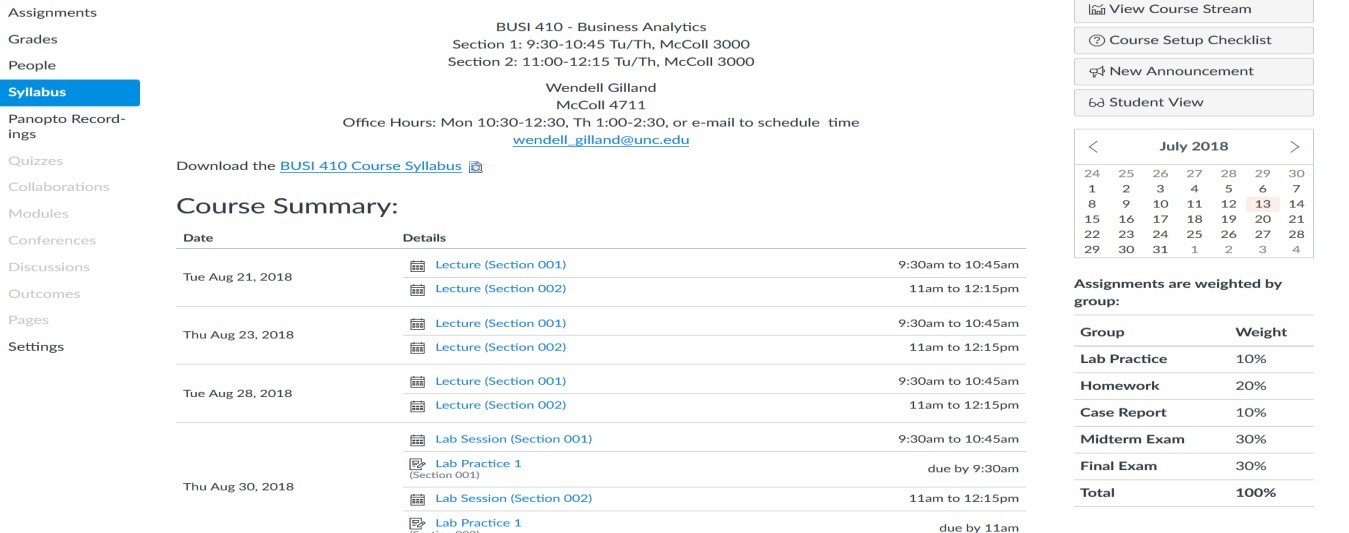
Grades
- After grading a student submission, enter score into Canvas.
- Put a disclaimer about grades in Canvas and/or the syllabus letting students know that the grades in Canvas are not the official grade for the course (e.g., “Final course grades determined at discretion of professor (i.e., overall score of 90+ may not guarantee/be required for an A or A-)”).

Calendar
- Create an Event for each class session indicating the topic of that day’s class. Then within the event, put links to the appropriate files (pdf’s, spreadsheets etc.)
- Include instructions for advance prep (readings, discussion questions, etc.) that students are expected to complete prior to class.
- “Use different date for each section” if teaching multiple sections so it will appear correctly on the students’ calendar.
- Be sure you are adding to the correct calendar if teaching multiple courses.
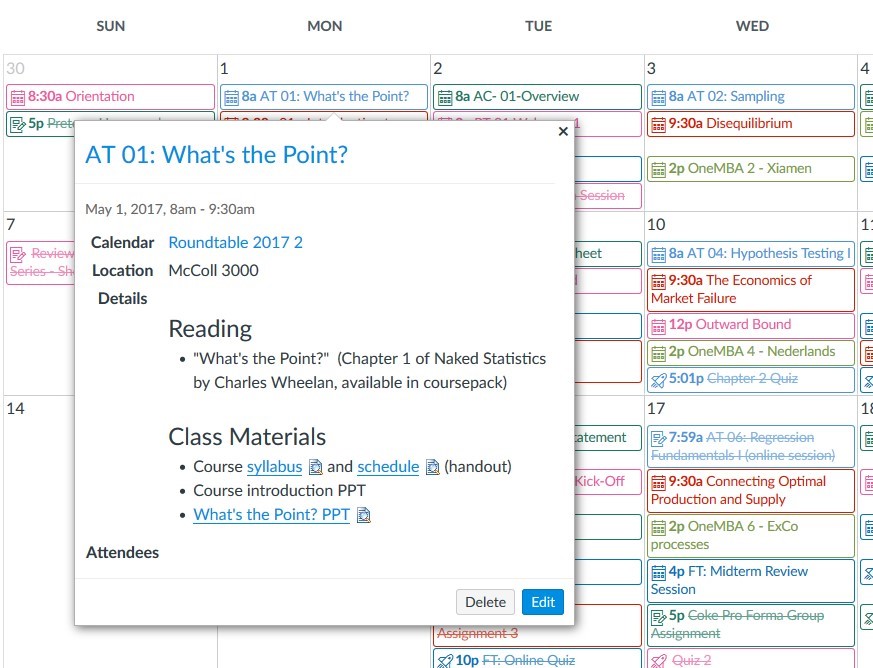
Schedule your live class sessions and recordings in Zoom through Canvas
Zoom is a video communications software that is used for video and audio conferencing, collaboration, chat, and webinars across mobile devices, desktops, telephones, and room systems. Zoom is available for all UNC Kenan-Flagler faculty, staff, and students; it offers the ability to host online meetings of up to 300 participants
To get started, Navigate to your Canvas course:
To get started, Navigate to your Canvas course:
-
Click Zoom on the Canvas Course Navigation

- Click Schedule a New Meeting inside of Canvas

-
Select your meeting settings:

- Topic: Title for the meeting
- Description (optional): This allows you to set a description for the meeting
- When: Date and starting time for the meeting
- Duration: How long the meeting lasts
- Time Zone: This should be set to EST since our courses take place in EST
- Recurring Meeting: This will allow you to schedule multiple meetings at once
- Registration: Registration should not be checked for course meetings in Canvas
- Video: It’s our recommendation that video be set to OFF by default for both Host and Participant
- Audio: This should be set to Both
- Meeting Options: Mute participants on entry
- Record the Meeting Automatically in the cloud should be used for all course meetings.
-
Click Zoom on the Canvas Course Navigation
-
Click Save; your meeting will now show up on under
Upcoming Meetings

- The students will have access to this page by clicking the Zoom tab in their course and will see the same view. This is also where they will access the cloud recordings.
Prepare for Technical Issues
Consider hosting a low-stakes online test session or connecting with colleagues to test your login, troubleshoot technical issues, and get used to the Zoom interface. Send students to the Zoom test and provide them with instructions to make sure that they are ready to go before your first official session; this will give students a chance to notify you if they have issues when setting up Zoom.
- Test and Familiarize yourself with the platform in advance.
- Arrive early enough to work out technical difficulties.
- Have a backup plan in case problems occur (Inform students of the backup plan ahead of time so they can remain on task if technical issues occur).
Connection Issues? Conserving Bandwidth on Zoom
If you are receiving “Your connection is unstable” messages in Zoom or notice stutter/distortion in your video and audio feeds, you are most likely experiencing a bandwidth issue. Below are some suggestions to make sure you have a stable connection and help minimize bandwidth use by Zoom.
Make sure you have a stable connection:
Make sure you have a stable connection:
- If you are using wireless, make sure that you are close enough to the access point and have adequate network connection on your device.
- Make sure there are no large files being downloaded on your device or any others that are connected to the same network you are utilizing Zoom on.
- Minimize use of other services that may utilize bandwidth while on the meeting, such as streaming services and online multiplayer video games.
-
Disable HD video on Zoom, moving to Standard Definition video should reduce the amount of bandwidth required to transmit video
- In your desktop Zoom client, click Settings (the gear icon).
- Click Video in the left-hand menu.
- In the My Video section, uncheck the box beside Enable HD if it is checked.
- If connection issues persist after disabling HD video, consider turning off video completely and only utilizing it when necessary. Ask participants to turn-off video unless required.
- Consider calling into the conference audio by phone instead of joining via computer audio, this will reduce bandwidth requirements by moving all audio handling to your phone.
- Only utilize Screen Sharing when necessary and consider turning off video while using it.
- Consider recording asynchronous content and sending it out to students; you can complement this with Zoom drop in hours to allow students to ask questions without the bandwidth usage of a full class session.
Virtual Courses or Sessions at Kenan-Flagler
Zoom In-Meeting Host Tools (Previously called Security)
During a meeting, the host or co-host can quickly enable or disable certain settings from the meeting controls toolbar to secure the meeting and minimize disruption; this includes locking the meeting, enabling waiting room, and suspending participant activities. The host and co-hosts can also view the security features this meeting was scheduled with while in the meeting.
Follow the instructions below to use In-Meeting Host Tools during your meetings:
You can find detailed descriptions for these options on the Changing security settings in a Zoom meeting support article
Follow the instructions below to use In-Meeting Host Tools during your meetings:
- Start a Zoom meeting
-
Click Host Tools.

-
Use this menu to enable or disable meeting features and participant settings:

You can find detailed descriptions for these options on the Changing security settings in a Zoom meeting support article
Zoom Participant Sharing Settings
By default, KF Zoom accounts are set to only allow host to share. Hosts can change this setting within a meeting or across all future scheduled meetings on their Zoom Account.
Changing Your Screen Sharing Settings in a meeting with the Host Tools Button in meeting
Find more information for participant share settings at Zoom Support via the Enabling screen sharing for participants in Zoom meetings support article
Changing Your Screen Sharing Settings in a meeting with the Host Tools Button in meeting
- Click the Host Tools Button
-
Click Screen Share to turn on Participant Screen Sharing (this will close the pop-up box)

- You can click the Host Tools button again to make sure Share Screen now has a check mark to the left; Screen share is now turned on.
-
Click the arrow next to Share Screen.

- Click Advanced Sharing Options.
- Click the radio button for All Participants.

- Sign in to the Zoom web portal.
- In the navigation panel, click Settings.
- Under In Meeting (Advanced), click the option for All Participants.

Find more information for participant share settings at Zoom Support via the Enabling screen sharing for participants in Zoom meetings support article
At the Start of the Meeting
Remind students of student conduct information at the start of each class session and let them know you will exercise your responsibility as an instructor to mute those who are disruptive or otherwise inappropriately interrupt classroom operations. You may want to email the class the link to the Kenan-Flagler Honor code and the University Student Code of Conduct https://catalog.unc.edu/policies-procedures/honor-code/Consider adding a similar statement to your Canvas syllabus
During the Meeting
Mute a Participant
- Click the Manage Participants button in the Zoom toolbar at the bottom of the Zoom window.
- Click the Mute button to the right of the participant name.
- Once all your participants have joined the room, you can prevent others from entering it.
- Click the Manage Participants button in the Zoom toolbar at the bottom of the Zoom window.
- Click the More button in the lower right of the participant panel.
- Select Lock Meeting.
- Confirm the selection.
- Click the Manage Participants button in the Zoom toolbar at the bottom of the Zoom window.
- Click the More button to the right of the participant.
- Click Remove.
- Confirm the selection.
- After removing the participant, acknowledge the disruption, apologize to the class and continue with instruction with remaining participants.
After the Meeting
Should a disruption occur, mute or quickly remove the attendee.If the participant is enrolled in the class, email the student following the session, clarify why the student was muted or removed, and remind them of appropriate conduct and expectations, and the disciplinary approach you will pursue.
Publishing Recordings
To get started, Navigate to your Canvas course:
-
Click Zoom on the Canvas Course Navigation

-
Click Cloud Recordings inside of Canvas

- Toggle the publish switch to make a recording available to your students
Meeting Attendance Report
As a licensed user, you have access to reports. Only meetings you've hosted as a licensed user (a paid user type) have reporting available.
Note: If a meeting was scheduled before you were licensed, but hosted after the license, then you will have reporting, but scheduling and hosting before the license will have no reporting available.
Note: If a meeting was scheduled before you were licensed, but hosted after the license, then you will have reporting, but scheduling and hosting before the license will have no reporting available.
- Sign in to the Zoom web portal.
- In the navigation menu, click Reports.
- Click the Usage Reports tab.
- Click Usage.
-
At the top, use the following functionalities to sort the data by meeting:
- Search by time range: Select a time range (within a month) using the From and To fields, then click Search.
- Search by meeting ID: Enter the meeting ID in the search box, then click Search.
-
Locate your meeting, then click the participant count (number) under the Participants Source column.
A list of internal and external meeting participants will appear. This will show you a list of meeting participants, including join and leave times. - (Optional) Export the attendee list as a CSV file.
Engage students: Zoom Features
You can use the features of Zoom to guide different types of interactive activities and offer some variety in online sessions; this will keep sessions interesting and offer

Setting the skin tone for your reactions
Managing nonverbal feedback and meeting reactions (hosts) Nonverbal feedback and meeting reactions will be displayed in each participant's video panel, as well as next to their name in the participants panel. Click the Participants button to see a full list of participants and their nonverbal feedback and meeting reactions.
In the participants list, you can view and manage feedback using these features:
Sharing Your Presentation in Zoom:
- Open your PowerPoint presentation on your computer
- Join the Zoom Session
-
Click the Share Screen button located in your Zoom tool bar.

-
Select your PowerPoint presentation in the prompt, and click the Share button to start sharing:
- Use the Slide Show button in PowerPoint to begin presenting
Screen annotation
Zoom has basic annotation tools (text box, free form draw/pen, shapes, and highlighter) that you can use to guide students or explain a concept. Access these tools by selecting the Annotate option when you're sharing your screen.Non-Verbal Feedback
To provide nonverbal feedback or reactions to the host of the meeting:- Join a Zoom meeting as a participant.
- Click the Reactions button.
-
Choose from the following icons or click • • • to choose from a full set of emojis. Click the icon again to remove it.

- Clapping Hands
- Thumbs Up
- Heart
- Tears of Joy
- Open Mouth
- Party Popper (Tada, Celebration)
- Yes
- No
- Slow Down
- Speed Up
- I'm away*
- Raise Hand / Lower Hand
*Note: The coffee cup "I'm away" nonverbal feedback requires the desktop client for Windows, macOS, and Linux; version 5.7.3 or higher.
Learn more about participant controls in a meeting.Setting the skin tone for your reactions
-
In the Zoom client, click your profile picture and then click Settings.

-
In the General tab, select your reaction skin tone.

Managing nonverbal feedback and meeting reactions (hosts) Nonverbal feedback and meeting reactions will be displayed in each participant's video panel, as well as next to their name in the participants panel. Click the Participants button to see a full list of participants and their nonverbal feedback and meeting reactions.
In the participants list, you can view and manage feedback using these features:
- If a participant clicked on a nonverbal feedback or meeting reaction icon, you'll see that icon beside their name.
- The number above each nonverbal feedback or meeting reaction icon shows how many participants have clicked on that icon.
-
If a participant clicked Raise Hand, you can lower their hand by hovering over their name and clicking Lower Hand.

- To clear all nonverbal feedback at once, click Participants, then, then Clear All Feedback.
- Emoji (meeting) reactions will disappear after 10 seconds, while raise hand and nonverbal feedback, such as Yes, No, Slow down, and Speed Up, will be persistent and must be manually removed by the participant or host.
Verbal Feedback
You can instruct students to use the "raise hand" feature to indicate questions or when they would like to add to a discussion; this allows students to remain muted until they would like to speak and prevents unnecessary background noise from interrupting the session.Chat
Using the chat tool allows students to interact with the session, activity, and each other; it even offers some advantages over large classroom settings:- Get large numbers of responses to a question immediately, and use these responses in real-time to drive discussion.
- Chat is especially useful to take in questions and answer them in order.
Breakout rooms
You can use Zoom’s breakout rooms functionality to facilitate group discussion or have students work. As the instructor, you can join breakout rooms, broadcast messages to the breakout rooms, and end the breakout sessions when it is time to regroup. Keep in mind that breakout rooms will not be recorded.Notes:- Only the main session room will be recorded
Self-Selected Breakout Rooms
Self-selecting a breakout room
Zoom breakout rooms allow you to split your Zoom meeting in up to 100 separate sessions. These can be split automatically, or manually, and allow participants to self-select breakout sessions. Pre-assigned breakout rooms are not recommended as they often do not catch all students and lead to instructors having to manually assign many students during the meeting.
More information and a video guide for Zoom Breakout rooms can be found on the Managing meeting breakout rooms support article
Zoom breakout rooms allow you to split your Zoom meeting in up to 100 separate sessions. These can be split automatically, or manually, and allow participants to self-select breakout sessions. Pre-assigned breakout rooms are not recommended as they often do not catch all students and lead to instructors having to manually assign many students during the meeting.
More information and a video guide for Zoom Breakout rooms can be found on the Managing meeting breakout rooms support article
Pre-record video
You can present slides to further explain a topic that was only touched upon in class or if several students ask the same question. Sessions can be recorded and shared for later viewing.
Write on the virtual Whiteboard
If you usually do "board work" as part of a class session, you have a number of options.
- Use the Whiteboard feature (this often works best on a tablet computer rather than a trackpad).
- Try the basic annotation tools (text box, free form draw/pen, shapes, and highlighter) to guide students or explain a concept.
- Create a PowerPoint slide or other simple backdrop file on which you can type notes, and share those notes using Screen Sharing. Note that one advantage of this and other approaches here is that the boards can persist and be distributed to the students after class.
- Prerecord the illustration as a video, then play it during class.






